The native Eastern Redbuds (Cercis canadensis) began blooming at Powell Gardens on March 19, 2012 and have held well through March 28th and into today. They usually begin peak bloom around April 10th at Powell Gardens so this was an early event this year and it has been spectacular! Redbuds reflect our spirit of place better than any other flowering tree as they are native to our site. Redbuds in flower hold well in our edge of the Great Plains location being wind and frost resistant as well as lasting for at least 10 days even in warm weather -- way longer than any crabapple, serviceberry and most other flowering trees.
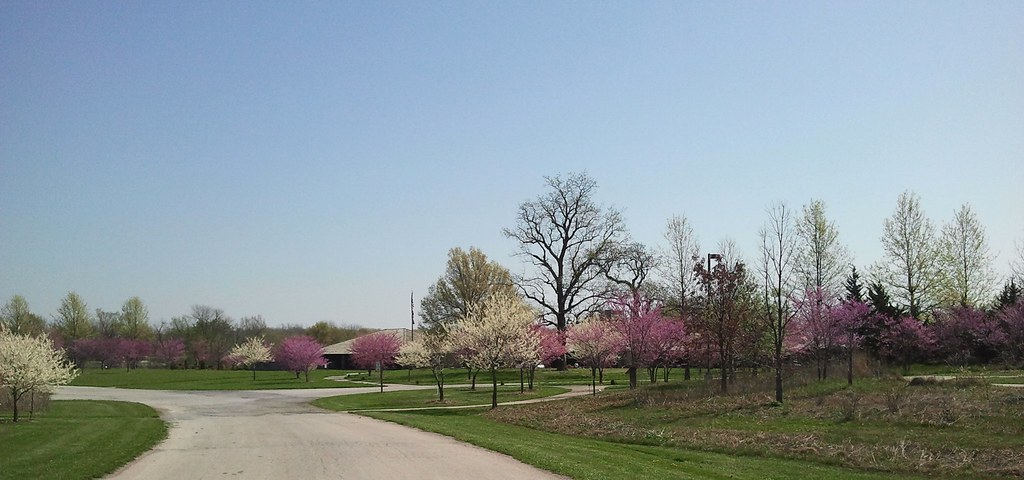
Here's a panorama looking towards the Visitor Center from the road between the parking lots. The redbuds and whitebuds (Cercis canadensis 'Alba') are really putting on a show!
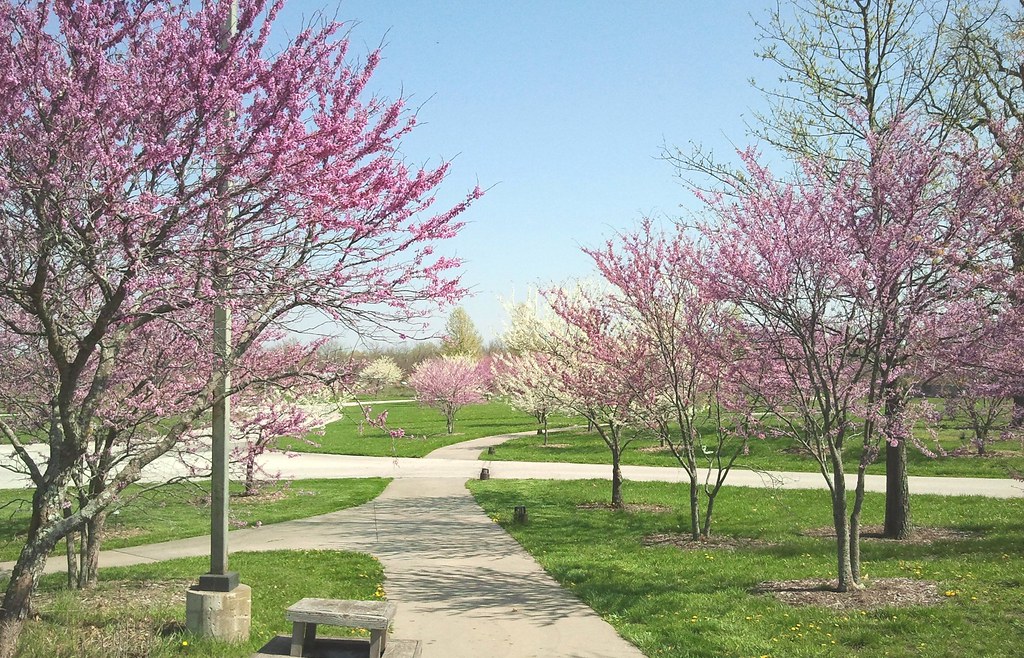
The walk from the parking lot to the Visitor Center is lined with Redbuds and Whitebuds -- someday it should create a tunnel-like experience, shading visitors as they walk from the parking lot to the building.
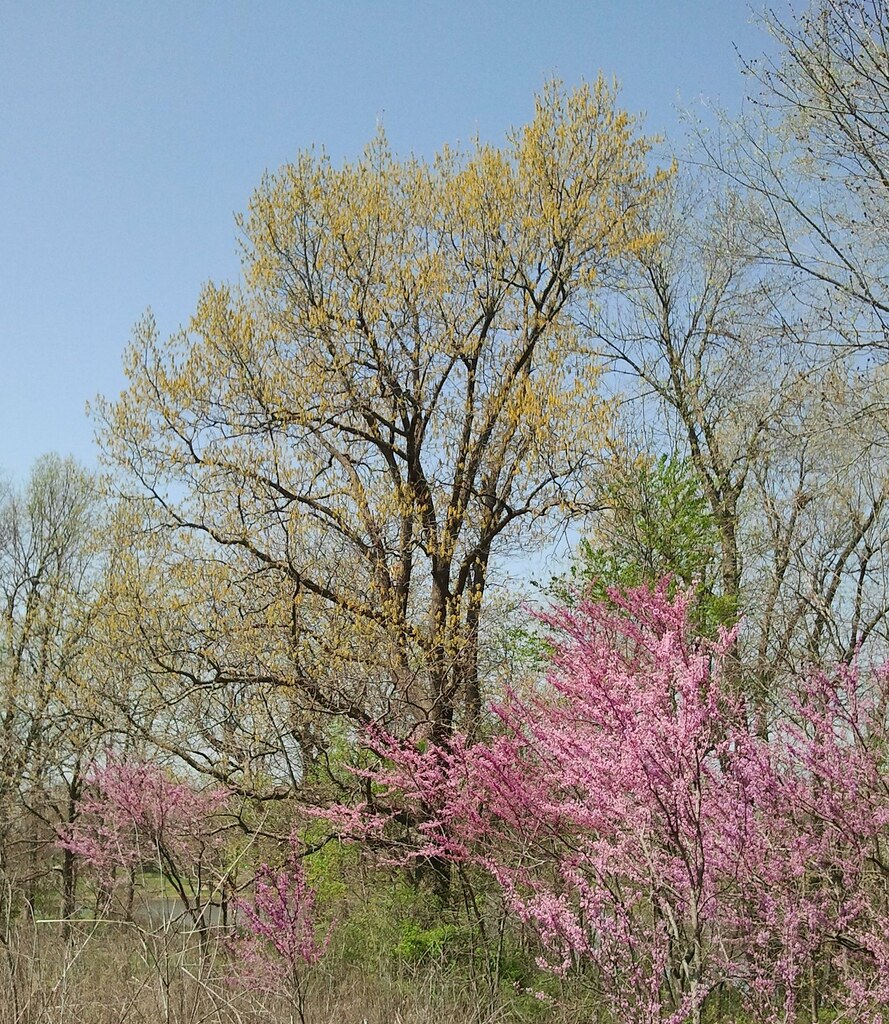
Redbuds look beautiful when growing like they would in nature: in masses at the edge of a woods. Their flower color is the perfect compliment for the yellow-greens of new foliage and less showy flowering trees like the tall Black Oak (Quercus velutina) blooming in this scene. Look for this composition between the Rock & Waterfall and Perennial Gardens.

Redbud's flower color actually is a blue-pink and looks fabulous against a blue sky and the perfect compliment for yellow-greens like the pin oak (Quercus palustris) on the right side of this image. Blue flowering plants also look beautiful beneath redbuds including native wildflowers like Virginia bluebells, Jacob's Ladder, Woodland Phlox, Butterfly Violets, and Crested Iris.
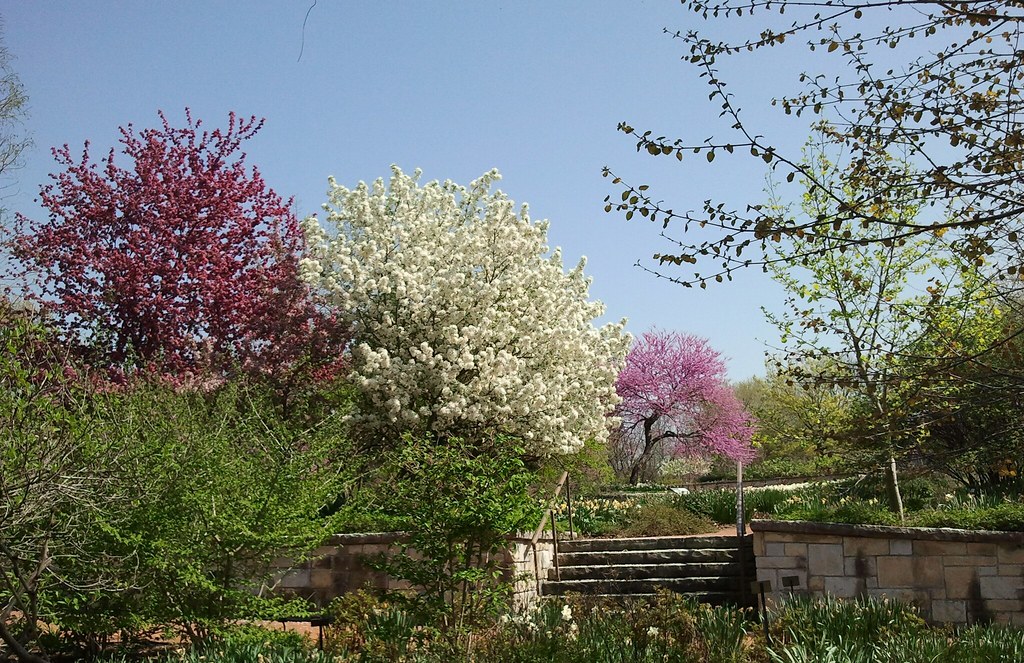
Flowering Crabapples (Malus cultivars) were also in bloom this week and this picture from the Perennial Garden shows: from left to right, a red-flowering 'American Masterpiece' crabapple, then a white 'Donald Wyman' crabapple and then a Redbud blooming beyond. Redbuds unique color CLASHES with red-flowering crabapples and pink or red-flowering dogwoods. Plant a white-flowering one to transition between these colors. Redbuds also clash with orange and red brick so be mindful of your landscape use of redbuds!

Redbuds go well with all colors of lilacs like this Mount Baker lilac (Syringa x hyacinthiflora) in white but blue or purple-flowering lilacs make beautiful compositions with redbuds.

Sunsation Magnolia is a later blooming "yellow" flowering magnolia. I think it is one of my favorites for its complex colors from lime to pink with various shades of yellow. It works exceedingly well in a planting with redbuds. Look for Sunsation Magnolia beside the Visitor Center trolley stop.
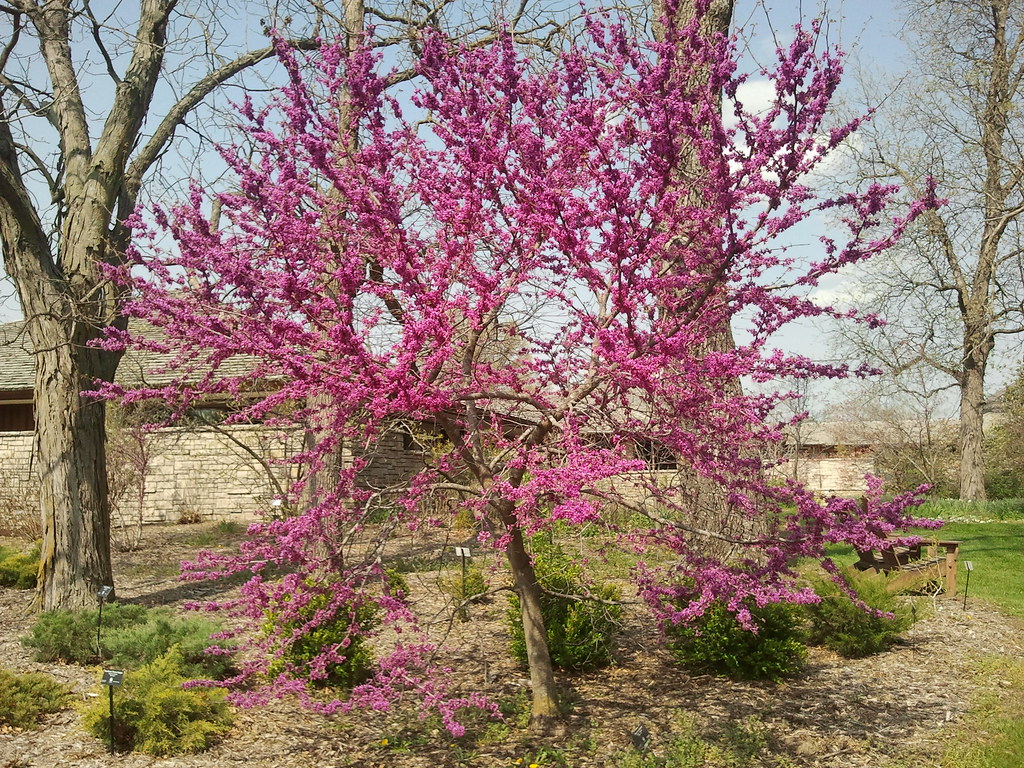
Here's and 'Oklahoma' Redbud (Cercis reniformis or C. canadensis var. texensis) which blooms a bit later with rosier colored flowers. Oklahoma Redbud was selected from the Arbuckle Mountains of Oklahoma and is exceedingly heat and drought tolerant with much more lustrous leaves than a typical redbud. This species or variety is found wild in Southern Oklahoma through Texas but is hardy here.

The Chapel's fountain (and the whole Chapel landscape) contains some of our best displays of Redbuds. Most of the Redbuds around the Chapel are Whitebuds (Cercis canadensis 'Alba') which is a cultivar that was originally found in the wild in Missouri. There is a newer cultivar 'Royal White' that is a bit hardier found in Illinois. It is hard to tell the two cultivars apart!
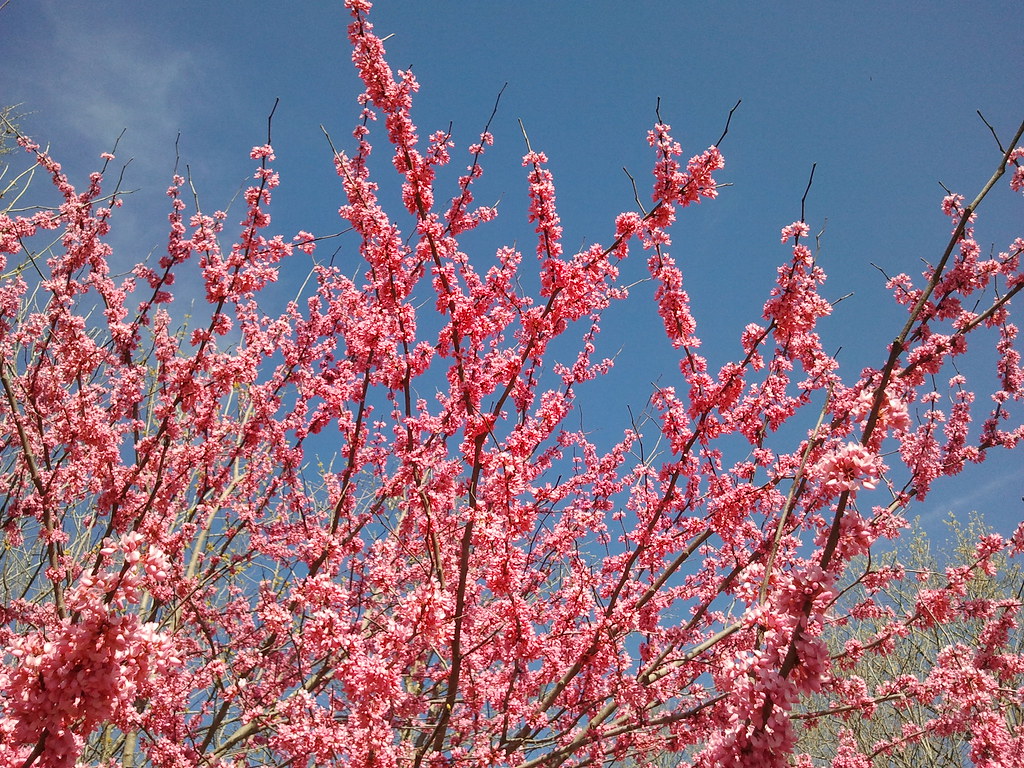
This photo is not touched up! It's Tennessee Pink Redbud growing on the walk to the Chapel. This redbud has cherry pink flowers and was a real stunner this spring. Appalachian Red is another cultivar with zippy, almost red-pink flowers.

This pinker Redbud is the older cultivar 'Rubye Atkinson' and is missing the blue overtone typical of redbuds. Look for this tree over near the Chapel Walk.

This pearly-pink Redbud is the cultivar 'Pauline Lily' and is a lovely, softest pink. Look for this tree near the Chapel trolley stop.

The redbud flowers are currently waning but some are still in lovely flower. (The picture is from the Chapel trolley stop looking towards the woodland walk to the Chapel.) The Flowering Dogwoods will open fully this weekend as will our Oriental wisterias on the Arbor in the Perennial Garden. Make sure to walk the Dogwood Walk from the Visitor Center to the Island Garden and over to the lakeside arbor in the Perennial Garden as it is rare for our wisterias to be so completely loaded with their purple, pendant and exceedingly fragrant blooms. Come celebrate the beauty of our landscape filled with spring-flowering trees!
Thursday, March 29, 2012
Reflecting on Redbuds
Posted by
Kansas City's botanical garden
at
12:43 PM
0
comments
![]()
![]()
Labels: flowering trees, spring, spring flowers
Wednesday, March 21, 2012
A Peachy Keen Landscape
The Powell Gardens' landscape will near its peak of spring this weekend, the earliest since 1987 from gardener's recollections--certainly the earliest in the 16 springs I have lived here. The Daffodils/Narcissus have been simply spectacular and the early flowering trees have been a breath of fresh springtime colors dancing across the gardens. The Heartland Harvest Garden's peach trees were simply a great joy to witness and we photo documented the entire collection because each variety has flowers that are either showy or not so much. This information is valuable to edible landscapes that want to balance beauty and productivity!

Here is the Peach Court in the Heartland Harvest Garden with its collection of almost 30 varieties of Peaches (Prunus persica and Nectarines var. nectarina). A few of the best cultivars are repeated on different rootstocks, smaller "semi-dwarf" rootstock closer in on the spiral and on "standard" rootstock where they will grow larger to full size on the outer ring of this garden.
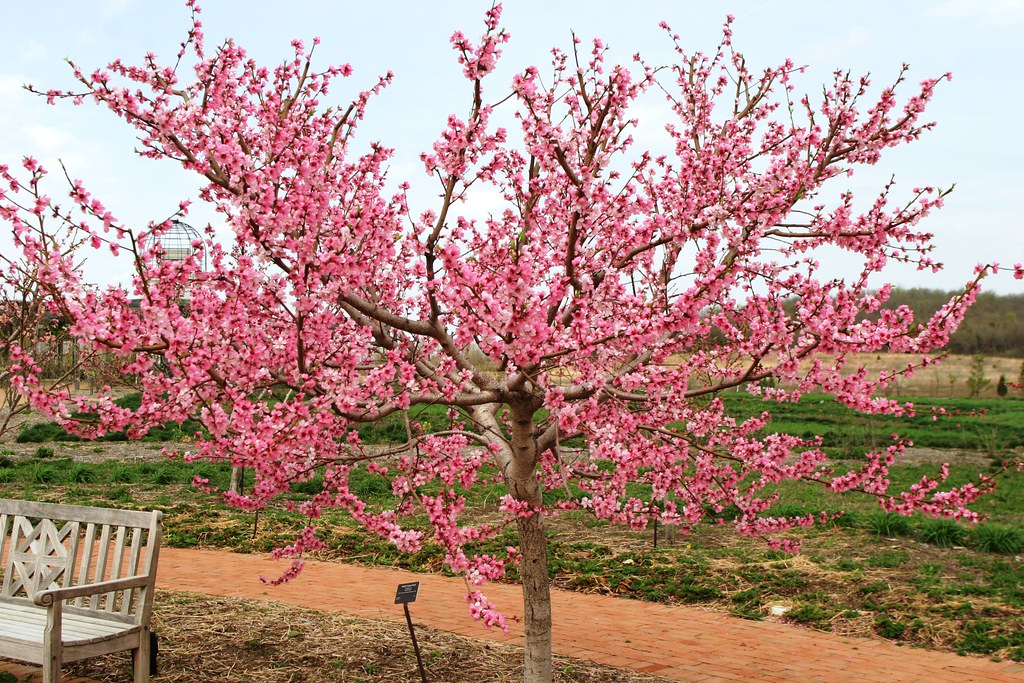
This a Stark 'Saturn' Peach which has some of the showiest, rosy-pink flowers. 17 of the Peach and Nectarine varieties have similar showy, rosy-pink flowers. Saturn Peach is a flat "doughnut" peach from Northern China that does very well in our climate and the peaches are funny looking but delicious!

Here's a closeup of a 'Stark CrimsonGold' Nectarine that fits the category of beautiful, showy-flowering peaches and nectarines.

This is the classic Missouri 'Redhaven' Peach which you can see has much smaller, carmine pink flowers that are much less showy in the landscape. We still recommend this variety for its superior peaches but in an edible landscape it looks even better mixed or paired with the showier flowering varieties.

Here's a closeup of 'Reliance' Peach which depicts a variety with less showy, carmine pink flowers. I actually split the less showy varieties into two groups: 11 with less showy carmine pink blooms (which included 'Reliance') and 10 varieties with the least showy carmine pink flowers (which included 'Redhaven' above). Most of the hardiest peaches with both extreme cold and frost tolerance have the less showy type flowers but 'Saturn' is an exception to that rule.

A very few peaches and peach hybrids have beautiful, showy soft pink flowers. This is our "Wilbur Kephart Indian" Peach, which is a family heirloom that was brought from Tennessee where Wilbur's forefathers found it growing wild (Wilbur is an 80-something local farmer, historian and Powell Gardens volunteer). Peaches are actually from China but traveled to Europe on the Silk Road, then via the Spaniards to the New World. The Native Americans quickly adopted the plant and spread it northward into Tennessee where it was already growing by the time settlers arrived. Think of the journeys this plant made!

The "Hardy" Almonds also have this beautiful soft pink bloom. This is the 'Reliable' Almond (Prunus x amygdalo-persica) which gets its hardiness from peaches as it is actually a peach-almond cross. It does produce dry fuzzy fruit with edible almonds in the pits. DO NOT EAT THE PITS OF REGULAR PEACHES as they are poisonous. True Almonds (Prunus dulcis) have white flowers and we have several new varieties hybridized in Russia that are doing well. Look for both 'Reliable' and 'Hall's Hardy' Almonds in our Vineyard.
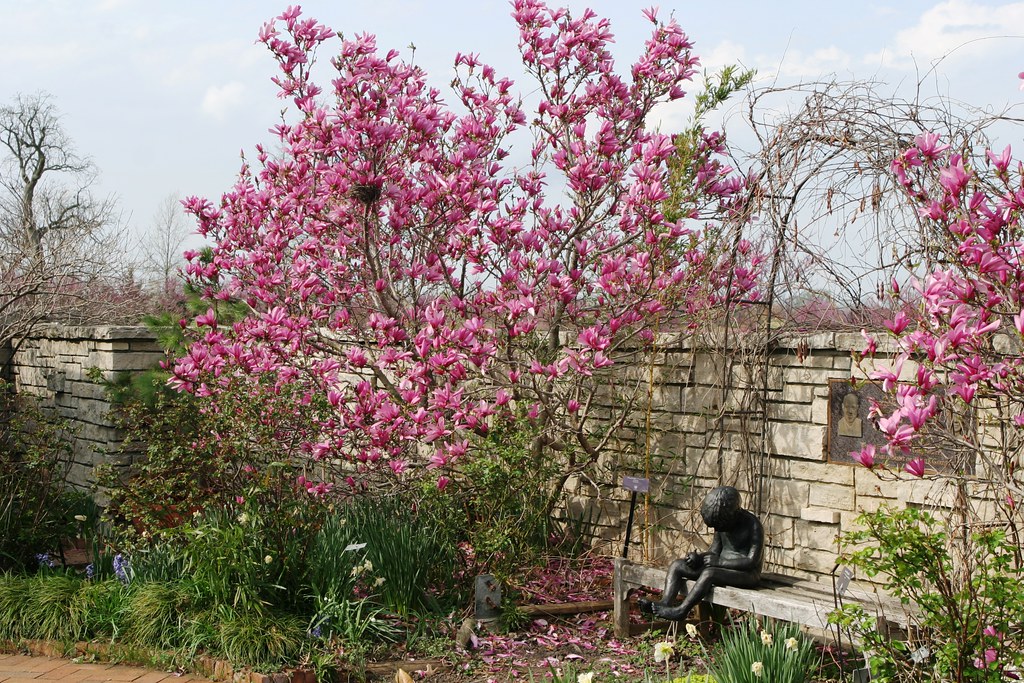
The mid season Magnolias are currently in full bloom throughout the gardens. Here is Ann Magnolia in full bloom in the Courtyard on the north side of the Visitor Center with a sculpture by the late Mary Kay Powell on the bench below the Powell Memorial plaque. Ann is one of the "Little Girl" Magnolias bred at the National Arboretum as hybrid crosses between Star and Lily Magnolias in an effort to get the frost resistance of Star Magnolia and the later bloom of Lily Magnolia. The best ones are named and we have 'Betty,' 'Jane,' 'Pinkie' and 'Randy' in other parts of the garden.
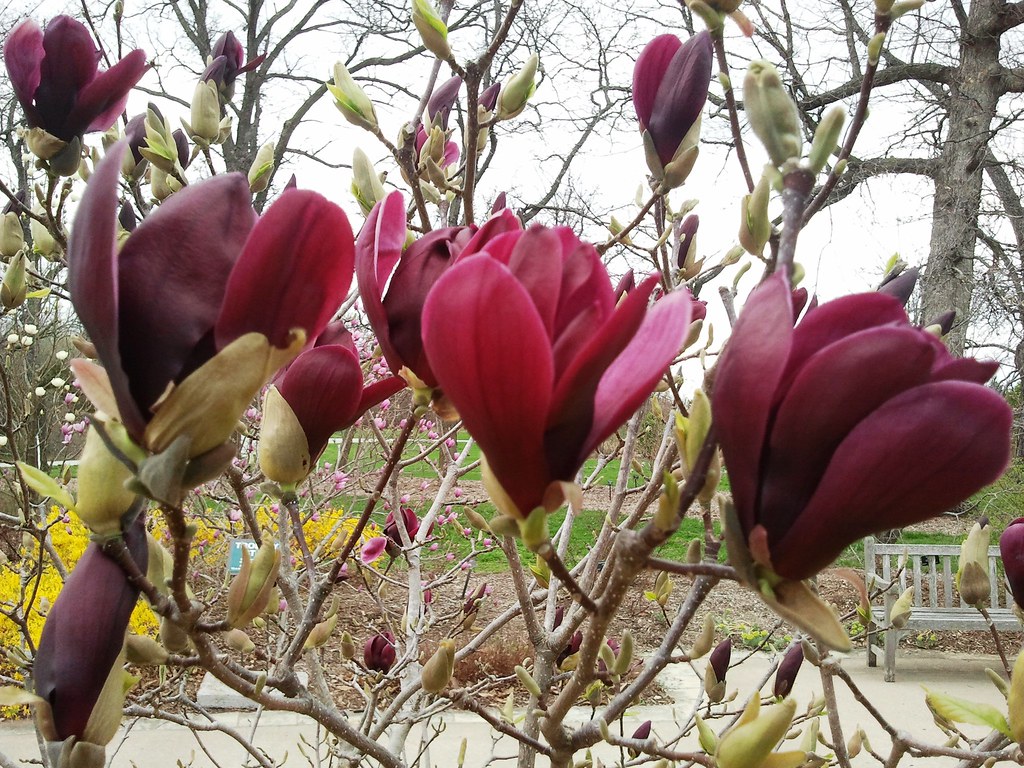
Here are the darkest flowering magnolias currently in bloom at the garden. This is the 'O'Neill' Lily Magnolia (Magnolia liliiflora) growing by the Visitor Center trolley stop. WOW is it vivid this year and seems to be deeper colored the warmer it is. Most varieties are just the opposite and are paler in warmer weather.
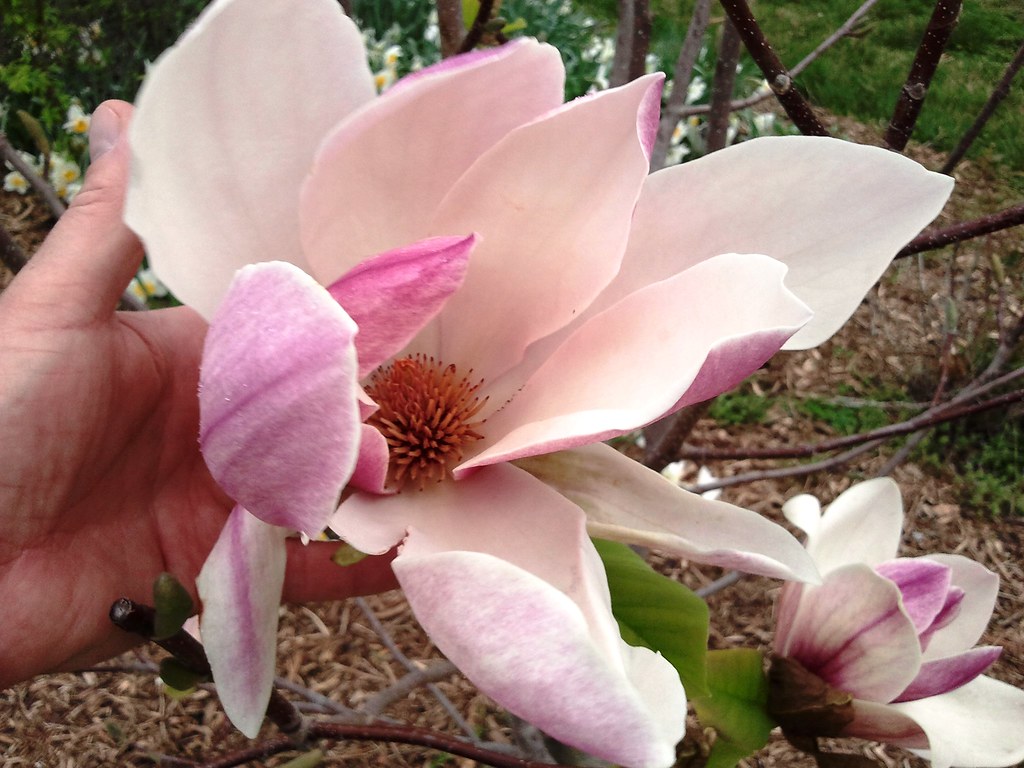
Look at this spectacular Magnolia blossom! This is a new cultivar called 'Toro' and is a hybrid with Missouri native Cucumbertree (Magnolia acuminata). It has HUGE flowers and is very hardy through zone 4. Look for Toro Magnolia blooming on the east edge of the Perennial Garden along the path to the Trigg Building.

Our native woodland wildlfowers are also making their graceful appearance. Linda Williams took this picture of White Trout-lily (Erythronium albidum) during the nature hike on Sunday on the Byron Shutz Nature Trail. Actually the best woodland wildflowers are along the first portion of that trail in the oak-hickory woods and include Spring Beauty, Toad Trillium, and Virginia Bluebells. Our showiest native tree is also going to be in full bloom this weekend: REDBUDS!!! They normally bloom about April 10th here but opened on March 19th out here this year. Come see them and all the other floral surprises of spring now in store for you at Powell Gardens.
Last weekend's tours of the Magnolia collections hit the peak of spring bloom on the early-mid "precocious" (blooming before the leaves) varieties but the mid-season varieties will be in peak flower for this weekend.
Posted by
Kansas City's botanical garden
at
10:39 AM
0
comments
![]()
![]()
Labels: magnolias, peaches, spring flowers, wildflowers
Tuesday, March 13, 2012
March Madness
Saturday was an absolutely perfect spring day with crystal blue skies and temperatures in the mid-60's. Sunday brought an all day, soaking rain which we really needed and Monday brought summer and simply an EXPLOSION of flowers. The calendar says mid-March but Mother Nature says its full blown SPRING!!!
Narcissus 'Carlton' is an absolute classic 'Large Cup' daffodil that naturalizes well in our climate -- these in the Perennial Gardens 'Mixed Perennial Border' have been here and thrived for over 20 years. These just opened so the corona or "cup" is orange but it will quickly fade to darker yellow.
Narcissus 'Las Vegas' is a show girl with huge, two-toned flowers of white and yellow. These are in the Rock & Waterfall Garden.
Posted by
Kansas City's botanical garden
at
3:04 PM
0
comments
![]()
![]()
Friday, March 2, 2012
Fabio Returns!
Spring has sprung at Powell Gardens and the return of many of the garden's birds are a sure sign of it. One of the earliest birds to arrive each year are the Red-winged Blackbirds which often return at the end of February whether there is snow on the ground or not. Last year, one particular male Red-winged Blackbird who resided on the Island Garden was named "Fabio" by Senior Gardener Caitlin Bailey. I witnessed the bird last summer when I was "on duty" at the Island Garden during our Booms and Blooms Festival. This particular male Red-wing is a show off and seems to delight in displaying to visitors on the Island Garden. He would often prance around the rocks of the spring water pool and show off the brilliant red epaulets on his wings to passers by! What a ham. Afterwards I mentioned the bird to Caitlin and she said "oh yes, that's Fabio!"
Happy Spring!
Posted by
Kansas City's botanical garden
at
11:10 AM
0
comments
![]()
![]()













